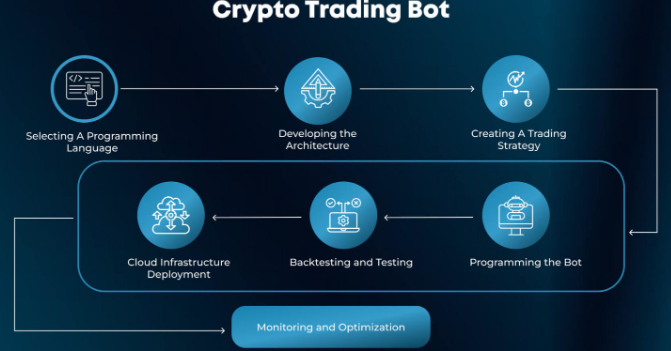How to Develop a Cryptocurrency Trading Bot
In the ever-evolving world of cryptocurrency trading, automation has become a game-changer. Developing your own cryptocurrency trading bot can give you an edge in the market, allowing you to execute trades 24/7 without emotional bias. Let’s explore the step-by-step process of creating your own crypto trading bot.
Choosing the Right Programming Language
The first crucial decision in developing your trading bot is selecting an appropriate programming language. Each language has its own strengths and weaknesses when it comes to bot development
| Language | Pros | Cons |
|---|---|---|
| Python | Easy to use, extensive libraries | Slower execution speeds |
| JavaScript | Good for web-based platforms, asynchronous | Less effective for heavy computational tasks |
| C# | High performance, efficient memory management | Steeper learning curve |
| Rust | High performance, memory safety | Potentially longer development time |
| Go | Strong concurrency support, high performance | Smaller ecosystem compared to Python |
Python is often the preferred choice due to its simplicity and robust library ecosystem, making it ideal for data analysis and machine learning applications
Setting Up API Connections
After choosing your programming language, the next step is to establish connections with cryptocurrency exchanges through their APIs. This allows your bot to send and receive data, enabling it to execute trades
Here’s a simple example of setting up a connection using the Binance API with Python:
from binance.client import Client
api_key = 'your_api_key_here'
api_secret = 'your_api_secret_here'
client = Client(api_key, api_secret)
# Get account information
account_info = client.get_account()
print(account_info)
Remember to replace ‘your_api_key_here’ and ‘your_api_secret_here’ with your actual Binance API credentials2.
Designing Your Trading Strategy
The heart of your trading bot is its strategy. Popular strategies include:
-
Trend Following: The bot identifies and trades based on market trends.
-
Arbitrage: Taking advantage of price differences between exchanges.
-
Market Making: Continuously buying and selling to profit from the spread
Your chosen strategy will significantly impact the complexity and design of your bot, so select one that aligns with your trading goals and expertise.
Coding and Testing
With your language chosen, API connected, and strategy defined, it’s time to start coding. This involves setting up your development environment, implementing your trading strategy, and thoroughly testing your bot2.
Here’s a basic example of a bot’s main loop in Python:
import time
symbol = 'BTC/USDT'
while True:
if should_buy(symbol):
print(f"Buying {symbol}...")
# Execute buy order
elif should_sell(symbol):
print(f"Selling {symbol}...")
# Execute sell order
time.sleep(60) # Wait for 1 minute before next check
Deployment and Monitoring
Once your bot is coded and tested, it’s time to deploy. Cloud platforms like AWS, Google Cloud, or Azure are popular choices for hosting trading bots due to their reliability and scalability
After deployment, continuous monitoring and optimization are crucial. Use tools like TradingView charts and indicators to assist in decision-making and refining your bot’s strategy
Remember, while trading bots offer significant advantages, they also come with risks. Always start with small trades, continuously monitor your bot’s performance, and be prepared to intervene if market conditions change dramatically
By following these steps and continuously refining your approach, you can develop a cryptocurrency trading bot that helps automate your trading strategy and potentially improve your results in the dynamic crypto market.
Also Read :
